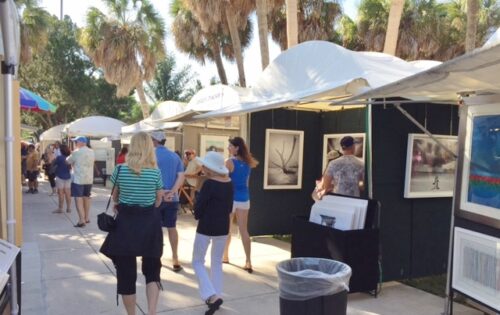by Carolyn Edlund
Your presence as the artist at a fair or festival is important, and what you do has a direct effect on sales. Keep these tips in mind for maximum engagement and increased sales.

Be present and accessible.
It’s surprising how often exhibitors aren’t present in their booths during festival hours. While sometimes this is unavoidable, more often than not, it’s due to artists feeling uncomfortable or stressed, leading them to socialize elsewhere or avoid interacting with the public. Working a show can indeed be stressful. Promoting your art or handmade work while trying to close sales is no easy feat. However, it’s essential to remember that you can’t sell anything if you’re not physically there.
If you’ve ever felt apprehensive about exhibiting or experienced anxiety in this environment, it’s crucial to confront those feelings head-on. Start by committing to being in your booth as much as possible and getting comfortable with that environment first. Converse with customers; don’t just hang back and hope your work sells itself.
Emphasize customer engagement.
The truth is, your personality, your story, and the connections you make with customers play a significant role in each sale. Collectors want to know about the artist behind the art, and people appreciate an engaging buying experience. So, make the effort to share your passion, and build those connections. It’s a vital part of the exhibiting experience.
The story you tell, the technique you explain, and the benefits you share, will be memorable to those who are interested in what you make. They will in turn share that information when showing others what they have purchased from you.
Even if it’s hard at first, take steps to improve your skills with customers. Make eye contact, speak about your work, and listen to them. Why are they at the festival? What do they enjoy about your art? What type of purchase are they considering? Are they interested in custom work, or would they like you to contact them after the show? The more you learn about your booth visitors, the more you can provide outstanding customer service, and the more opportunities you will have to close the sale.
Place the item in their hands.
This is a powerful nonverbal way to help your customer begin to feel a sense of ownership of the item they are considering. Touch is a vital key to making sales. Encourage them to feel the weight, texture, and quality of what you make. For wearable items, suggest they try on the piece with a mirror at hand so they can appreciate how your work looks and how it makes them feel.
Speak to the group.
Shoppers often attend festivals with friends and family. When you answer questions and speak with the shopper, be sure to include their companions, using eye contact and a smile to keep them in the loop, too.
Have you ever noticed that many times the friend who is present also makes a purchase? Don’t overlook this possibility. They might become an additional customer for you, or even be the one holding the credit card. Companions often have a huge influence on the shopper’s decision to buy, which is why acknowledging them and including them in your conversation is a good idea. When you show respect and acknowledge them, they know they are seen and heard, not ignored. Their positive response will help when they are asked their opinion about whether your customer should buy.
Know your selling points and how to deal with objections.
Do you know the reasons why people don’t buy your work? Sure you do. It’s too expensive, the wrong color, too heavy, or whatever. Listen to shoppers to hear their concerns so that you can understand why sales aren’t made, and then deal with those objections either before they happen or through overcoming them during the sales process.
Why should people buy your work? You must know the reasons why and be able to speak about them fluidly. You won’t just be rattling off a list of reasons, but instead be able to engage in meaningful conversation with shoppers who are considering a purchase. Each benefit of buying that you point out can alleviate their concerns and build their confidence. Helping people to make the right buying decision is actually a customer service. Do your best to make recommendations that will help your customer buy a piece of your work that is right for them.
Gather contact information.
People make a purchase when they are ready. Do they have a need for what you are selling? Can they afford it at this time? Do they have all the information they need to make the buying decision?
The art fair where you meet prospective customers is often just a starting point. They see your work and they like it. You share your story, and they get to know you. But they aren’t ready to buy just yet. Getting their names and contact info is essential, because it allows you to stay in touch and keep your work in front of them on an ongoing basis. Then, when the time comes that they are ready for the purchase, they will know you, trust you, and be more likely to purchase from you.
Don’t let your next fair or festival become a “single opportunity” to make sales. Use a guest book or collect their email address, or get their contact info electronically, or exchange business cards. Put them on your list and stay in touch. This one activity will result in making sales after the show, closing repeat sales, and gaining referrals to other new prospective customers.


Speak Your Mind